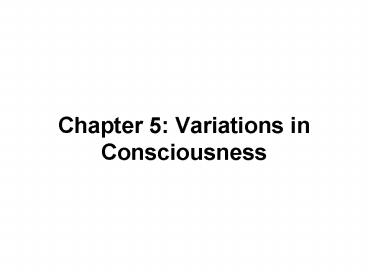Chapter 5: Variations in Consciousness - PowerPoint PPT Presentation
1 / 25
Title:
Chapter 5: Variations in Consciousness
Description:
A Physiological Index of Consciousness. EEG monitoring of brain electrical activity ... accidents: Chernobyl, Exxon Valdez. Selective deprivation ... – PowerPoint PPT presentation
Number of Views:96
Avg rating:3.0/5.0
Title: Chapter 5: Variations in Consciousness
1
Chapter 5 Variations in Consciousness
2
Consciousness Personal Awareness
- Awareness of Internal and External Stimuli
- Levels of awareness
- James stream of consciousness
- Freud unconscious
- Sleep/dreaming research
3
The ElectroencephalographA Physiological Index
of Consciousness
- EEG monitoring of brain electrical activity
- Brain-waves
- Amplitude (height)
- Frequency (cycles per second)
- Beta (13-24 cps)
- Alpha (8-12 cps)
- Theta (4-7 cps)
- Delta (lt4 cps)
4
Table 5.1 EEG Patterns Associated with States of
Consciousness
5
Biological Rhythms and Sleep
- Circadian Rhythms 24 hr biological cycles
- Regulation of sleep/other body functions
- Physiological pathway of the biological clock
- Light levels ? retina ? suprachiasmatic nucleus
of hypothalamus ? pineal gland ? secretion of
melatonin - Melatonin and circadian rhythms
6
Sleep/Waking Research
- Instruments
- Electroencephalograph brain electrical activity
- Electromyograph muscle activity
- Electrooculograph eye movements
- Other bodily functions also observed
7
Sleep Stages Cycling Through Sleep
- Stage 1 brief, transitional (1-7 minutes)
- alpha ? theta
- hypnic jerks
- Stage 2 sleep spindles (10-25 minutes)
- Stages 3 4 slow-wave sleep (30 minutes)
- Stage 5 REM, EEG similar to awake, vivid
dreaming (first a few minutes, then longer) - Developmental differences in REM sleep
8
The Architecture of Sleep
- How quickly one falls asleep, how long one
sleeps, how one cycles through the various stages - Varies from one person to the next
- Each of us has a signature sleep pattern mostly
shaped by biological factors rather than personal
habits
9
Figure 5.5 An overview of the cycle of sleep
10
Figure 5.5 An overview of the cycle of sleep
11
The Neural Bases of Sleep
- Brain Structures
- Ascending reticular activating system
- Pons, medulla, thalamus, hypothalamus, and limbic
system - Neurotransmitters
- Acetylcholine and serotonin
- Also norepinephrine, dopamine, and GABA
12
Figure 5.8 The ascending reticular activating
system (ARAS)
13
Why Do We Sleep?
- Hypothesis 1
- Sleep evolved to conserve organisms energy
- Hypothesis 2
- Immobilization during sleep is adaptive because
it reduces danger - Hypothesis 3
- Sleep helps animals to restore energy and other
bodily resources
14
Sleep Deprivation
- Complete deprivation
- 3 or 4 days max
- Partial deprivation or sleep restriction
- impaired attention, reaction time, coordination,
and decision making - accidents Chernobyl, Exxon Valdez
- Selective deprivation
- REM and slow-wave sleep rebound effect
15
Sleep Loss and Health
- Sleep loss can affect physiological processes
- Sleep restriction appears to trigger hormonal
changes that increase hunger - Studies have found a link between short sleep
duration and increased obesity - Mortality rates are especially high among those
who consistently sleep over 10 hours
16
Figure 5.10. Mortality rates as a function of
typical sleep duration.
17
Sleep Problems
- Insomnia difficulty falling or staying asleep
- Narcolepsy falling asleep uncontrollably
- Sleep Apnea reflexive gasping for air while
asleep - Nightmares anxiety arousing dreams - REM
- Night Terrors intense arousal and panic - NREM
- Somnambulism sleepwalking
18
Figure 5.12 The vicious cycle of dependence on
sleeping pills
19
Figure 5.13 Sleep problems and the cycle of sleep
20
Dreams and DreamingContent and Significance
- Dreams mental experiences during sleep
- Content usually familiar
- Common themes
- Waking life spillover day residue
- Western vs. Non-Western interpretations
21
Figure 5.15 Three theories of dreaming
22
Hypnosis Altered State of Consciousness or Role
Playing?
- Hypnosis a systematic procedure that increases
suggestibility - Hypnotic susceptibility individual differences
- Effects produced through hypnosis
- Anesthesia
- Sensory distortions and hallucinations
- Disinhibition
- Posthypnotic suggestions and amnesia
23
Meditation
- Meditation practices that train attention to
heighten awareness and bring mental processes
under greater voluntary control - Yoga, Zen, transcendental meditation (TM)
- Potential physiological benefits
- Similar to effective relaxation procedures
24
Psychoactive drugs
- Narcotics (opiates) pain relieving
- Sedatives sleep inducing
- Stimulants increase CNS activity
- Hallucinogens distort sensory and perceptual
experience - Cannabis produce mild, relaxed euphoria
- Alcohol produces relaxed euphoria, decreases
inhibitions - MDMA produces a warm, friendly euphoria
25
Table 5.3 Psychoactive Drugs Tolerance,
Dependence, Potential for Fatal Overdose, and
Health Risks































